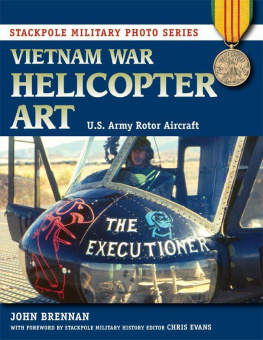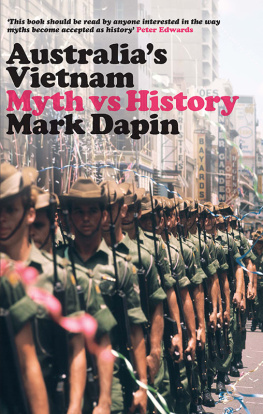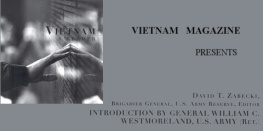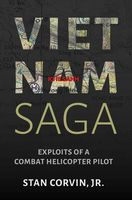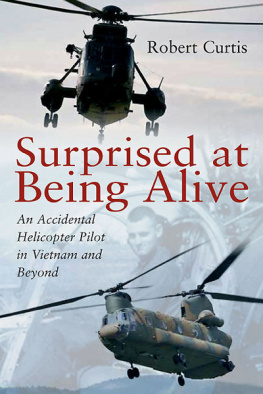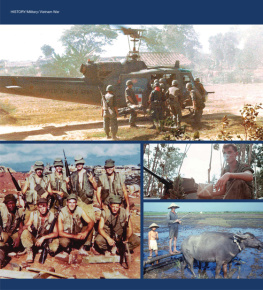
The military tradition of tagging aircraft ostensibly grew from the squadron flashes painted on the fuselages of World War I airplanes. During World War II, this resulted in the common practice of pilots and crews giving their airplanes pet names with a specific, personalized meaning. While much has been done to record the evidence of this during the world wars, Brennans volume is the first real attempt to catalog the depth and breadth of that tradition during the Vietnam era.
R. S. Maxham, Director of the U.S. Army Aviation Museum, Fort Rucker, Alabama
John Brennan has assembled a masterpiece.
Hugh L. Mills Jr., C Troop, 16th Cavalry
This is another way to pay tribute to the vets. There was nothing very glamorous in this war or about flying. It was exhausting, often frustrating, sometimes gratifying, and always dangerous work. The fact that people had the time, enthusiasm, and materials to decorate their aircraft says something about those of us who served. We produced some of the most colorful, provocative, imaginative, and artistic creations ever seen on aircraft.
Bob Chenoweth, 4th Transportation Company/120th Assault Helicopter Company/58th Aviation Company
Thanks for the work youre doing. I hope it makes young ones down the line realize that we flew with courage, fought like banshees, and the ones we lost died like warriors.
Greg Monroe, 187th Assault Helicopter Company
Thanks for taking the time to put these pages of history together for those who never made it backand maybe some of their children who know little or nothing about this era.
Clarence Jackson, 17th Assault Helicopter Company
Seeing these pictures again sends chills down my back.
David Kilborn, 147th Assault Support Helicopter Company
We grew up on these helicopters in Vietnam. You never get over them.
Jim Demumbreum, 57th Assault Helicopter Company
Copyright 2012 by John Brennan
Published by
STACKPOLE BOOKS
5067 Ritter Road
Mechanicsburg, PA 17055
www.stackpolebooks.com
All rights reserved, including the right to reproduce this book or portions thereof in any form or by any means, electronic or mechanical, including photocopying, recording, or by any information storage and retrieval system, without permission in writing from the publisher. All inquiries should be addressed to Stackpole Books.
Cover design by Caroline M. Stover
Printed in China
10 9 8 7 6 5 4 3 2 1
Library of Congress Cataloging-in-Publication Data
Brennan, John, 1948
Vietnam War helicopter art : U.S. Army rotor aircraft / John Brennan ; with a foreword by Chris Evans.
pages cm
ISBN 978-0-8117-1031-2
eISBN 978-0-8117-4894-0
1. Military helicoptersDecorationUnited States. 2. Vietnam War, 19611975Art and the war. I. Title.
UG1233.B75 2012
959.704348dc23
2012006356
CONTENTS
FOREWORD
M ention the Vietnam War and images of helicopters slashing over thick green jungle and watery brown rice paddies instantly spring to mind. What the horse was to the cavalry of the Civil War, the helicopter was to the U.S. Army in Vietnam, especially the air cavalry. Unlike World War II and Korea, the war in Vietnam ushered in the concept of air mobilityusing helicopters to ferry troops to specific locations to engage in battle and then, the battle over, take the troops back out again. This was a far cry from the methodical march in earlier conflicts where every yard of territory was occupied as an army pushed ever forward en masse. In addition to transporting troops, the versatility of the helicopter saw it provide tactical air support, supply, reconnaissance, andperhaps most crucialmedical evacuation of the wounded.
Much as the Stackpole Military History Series began with several World War II titles and then expanded to explore other conflicts, the Stackpole Military Photo Series now moves to the war in Southeast Asia. In addition to marking the first book in this new series of wartime photographs that isnt about World War II, Vietnam War Helicopter Art is also the first full-color book in the series. Since color film was widely available in the 1960s, the Vietnam War became the first in history to be significantly photographed in color.
Whether it was knights on horseback with shields emblazoned with their coat of arms or fighter and bomber pilots dedicating their planes to a girlfriend, wife, or even a cartoon character, soldiers going into battle have always found ways to personalize their weapons and vehicles. The pilots and aircrew flying helicopters in Vietnam were no different. And with the many large, flat surfaces available on rotor aircraft like the Huey, their creative talents really took flight!
The author of this book is no stranger to helicopters in war. John Brennan served a twelve-month tour in the Mekong Delta region of Vietnam in 197071, where he was assigned to the U.S. Armys 114th Assault Helicopter Company as a Flight Operations Coordinator. It was during his tour that he saw firsthand the varied and colorful names, cartoons, and other paintings that crews were adorning their helicopters with. He never forgot those images, and after the war, he embarked on a multi-year project to track down as many images as he could. But John didnt stop there. Wherever possible, he interviewed the crews to find out where they served, who came up with the artwork, and what it meant to them.
The following book is a meticulously researched and visually stunning collection of funny, dark, sexy, and even downright strange artwork that flew the skies of Vietnam on everything from gunships to Dustoffs and on helicopter types as varied as the AH-1 Cobra and CH-54 Flying Crane. The art served as good-luck charms, personal messages, warnings to the enemy, and a way to stand out and say, There might be a lot of helicopters in Vietnam, but this one is mine. From the nose of a Huey wearing a very mean-looking Thunder Chicken to rocket pods painted up like beer cans, the creativity and skill of the men who painted these works of art are matched only by their bravery, dedication, and, above all, their loyalty and friendship to one another.
Chris Evans
Editor
Stackpole Books
INTRODUCTION
T his collection of helicopter artwork represents a showcase of mostly never-before-seen images that reflect the bond between man and machine. Although now more than forty years old, these photos nonetheless offer a peek into the American character as it expressed itself in paint on metalinsightful and nostalgic, undeniably authentic and true. Ultimately, the book is a personal attempt to rectify an oversight long perpetuated by historys fickle hand and to secure some overdue recognition for those men whose creativity placed morale-building images on an otherwise green void.
For this book, nose art is considered to be any markings, including stylistically rendered aircraft names, that personalized a helicopterin contrast to official military markings, such as unit and platoon designations. These official markings are not featured here. Nor are unit and platoon nicknames or crew names and nicknames.
Although a great deal of ground is covered, this book is an exploration of the subject, not an exhaustive study. Many inroads were made and new territory examined, yet much remains unexplained, with countless images unseen. Unfortunately, all units and all aircraft types are not represented in this volume. I relied heavily on responses from veterans, and the range of photos reflects those reponses. Furthermore, I selected photos based on clarity, quality, and content. Less than 5 percent passed muster on all three counts. Without a doubt, the best nose art images from the Vietnam War were captured on 35mm Ektachrome and Kodachrome slide film.

